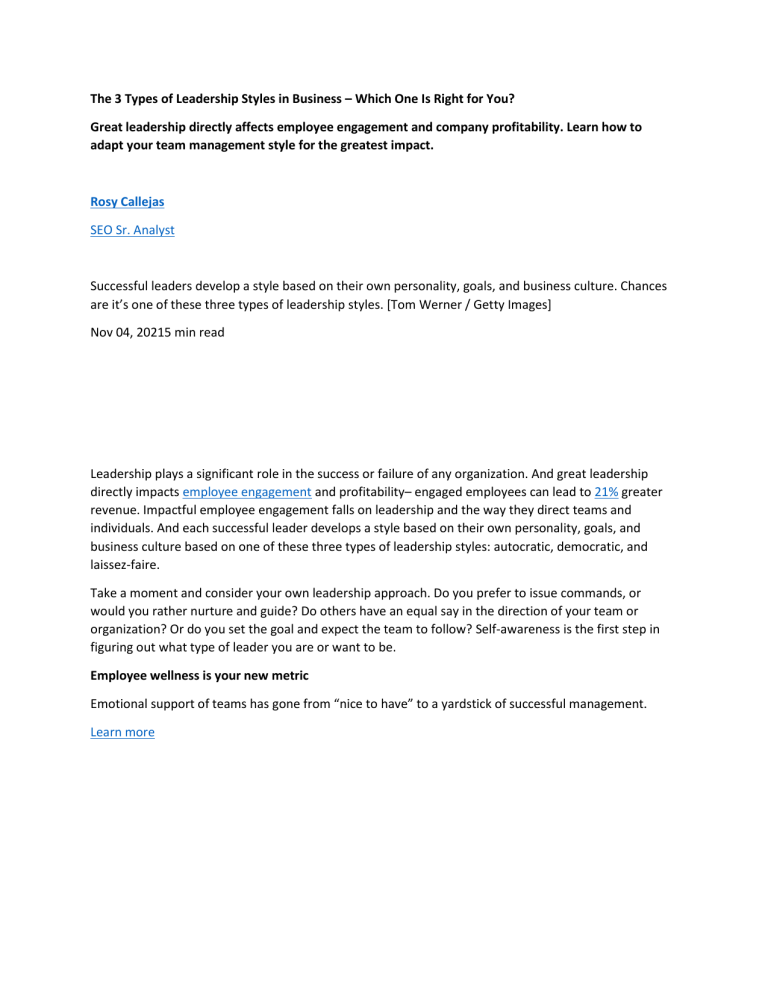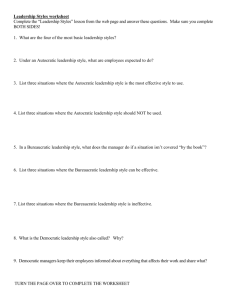Uploaded by
Choung Chamreun
3 Leadership Styles: Autocratic, Democratic, Laissez-faire
advertisement

The 3 Types of Leadership Styles in Business – Which One Is Right for You? Great leadership directly affects employee engagement and company profitability. Learn how to adapt your team management style for the greatest impact. Rosy Callejas SEO Sr. Analyst Successful leaders develop a style based on their own personality, goals, and business culture. Chances are it’s one of these three types of leadership styles. [Tom Werner / Getty Images] Nov 04, 20215 min read Leadership plays a significant role in the success or failure of any organization. And great leadership directly impacts employee engagement and profitability– engaged employees can lead to 21% greater revenue. Impactful employee engagement falls on leadership and the way they direct teams and individuals. And each successful leader develops a style based on their own personality, goals, and business culture based on one of these three types of leadership styles: autocratic, democratic, and laissez-faire. Take a moment and consider your own leadership approach. Do you prefer to issue commands, or would you rather nurture and guide? Do others have an equal say in the direction of your team or organization? Or do you set the goal and expect the team to follow? Self-awareness is the first step in figuring out what type of leader you are or want to be. Employee wellness is your new metric Emotional support of teams has gone from “nice to have” to a yardstick of successful management. Learn more What are the three types of leadership styles in business? In 1939, Kurt Lewin identified three types of leadership styles in business: autocratic, democratic, and laissez-faire. Each, of course, comes with its own advantages and disadvantages. 1. The autocratic business leader The autocratic leader understands the strength of authority. Autocratic leaders are not interested in opening up the decision-making process to the entire group. Instead, they choose to bear the leadership completely alone. They expect those who fall under their authority to follow orders. Advantages of an autocratic business leader The main advantage of an autocratic leader is streamlined work that improves efficiency and productivity. They create firm deadlines and have a very clear set of expectations. This is ideal in a time of crisis or when last-minute decisions are needed. This leadership style allows for fewer misunderstandings as directions are passed down. The disadvantages of an autocratic business leader They often have a limited perspective. Given that they only draw from their own ideas and experience, any input from other members of the team will likely go unspoken. Those who work under this leadership style sometimes end up resenting their manager. They feel undervalued due to limited recognition of their contributions. Additionally, this leader is more likely to micromanage their team. Autocratic leaders tend to find themselves at the center of low work morale and high employee turnover. When to use this style The autocratic style is best used during a crisis when a leader is most valuable. You need someone who takes control to make quick and difficult decisions to potentially reduce damage. During times of emergency, teams appreciate a strong and decisive leader. Autocratic leadership may also come in handy when team correction is necessary. After the crisis has passed, it is generally beneficial to switch styles. 2. The democratic business leader A democratic leader encourages the free exchange of ideas throughout the team. All members have a valued voice and the leader acts as a spokesperson or facilitator. Democratic leaders rely on the participation of every member of the group. They emphasize the value and expertise each member brings to the table. Every team member shares the freedoms and responsibilities of leadership. Advantages of a democratic business leader An advantage of democratic leadership is the boundless creativity of the entire group that allows for open discussion of issues and solutions. Team unity generally grows as a result of democratic leadership. This environment can make an employee feel appreciated, accomplished, and important to the success of the organization. Common office politics such as gossiping, cliques, and manipulation become much less prevalent. The end result is an improved work environment and lower employee turnover: 63% of employees who are recognized for their work are less likely to job hunt. The disadvantages of a democratic business leader Under democratic leadership, deliberation can be an unaffordable luxury. If decisions need to be made quickly, a democratic team may be unable to adapt and function under the stress. Democratic leadership can result in a lack of clarity around team members’ roles and responsibilities, and difficulty identifying employees who aren’t carrying their weight. When to use this style This is the most effective method for day-to-day work as it allows the group to take part in decisionmaking. This gives teams a feeling of ownership over projects, deliverables, and results. Many business leaders identify the democratic leadership style as their go-to style, but this technique can be less effective during times of crisis. 3. The laissez-faire business leader Laissez-faire leaders are the hands-off type. They assign tasks and give general direction but they’re usually uninvolved in day-to-day tasks. Employees decide on the best approach to fulfill their responsibilities. Laissez-faire leaders put a great amount of faith in the individual. They trust them to remain self-motivated, on-task, and accountable. If issues arise, these leaders are available to offer direction, but only upon request. Laissez-faire leaders allow each member of their team to succeed or fail based on their own abilities. Advantages of laissez-faire business leaders An advantage of laissez-faire leadership is the freedom to operate without restrictions or interference from management. This gives skilled and self-motivated employees a chance to reach their fullest potential. The disadvantages of laissez-faire business leaders A disadvantage can be the loss of productivity without a strong leadership hand to keep it on track. This can result in missed deadlines, omissions in the process, and low-quality work. With each team member pursuing goals in their own way, team unity may suffer. Some may start to lose interest in work due to distant and seemingly uninterested leaders. This can lead to significant losses for the organization. Disengaged employees can cost American businesses an estimated $450-550 billion per year. When to use this style Laissez-faire leadership is best when individuals are able to function without supervision. Before using this style, make sure each team member has the right skill level and self-direction capability. They must be able to motivate themselves to keep the work going. Otherwise, this approach could backfire and cause more harm than good. Choose your type of leadership style Review your current team dynamic. Are they excelling or unengaged? If it’s the latter, you might want to review your methods. Figure out what needs to stay the same and what needs to change. A leader sets the tone for the entire team. By changing the way you lead, you may find that your team will adapt, evolve, and improve. Which business leadership style is right for you? You may find that you don’t fit neatly into any one category. The most successful leaders are those who jump between leadership styles. Pick and choose techniques that best fit the team or task at hand and adapt them along the way as needed. Effective leadership is, and always has been, about knowing what techniques to use and when. The most important leadership skill that you can develop is self-awareness; know what works and what doesn’t. By understanding these most common business leadership styles, you’ll be able to move between them as needed, and set yourself and your team up for success.






